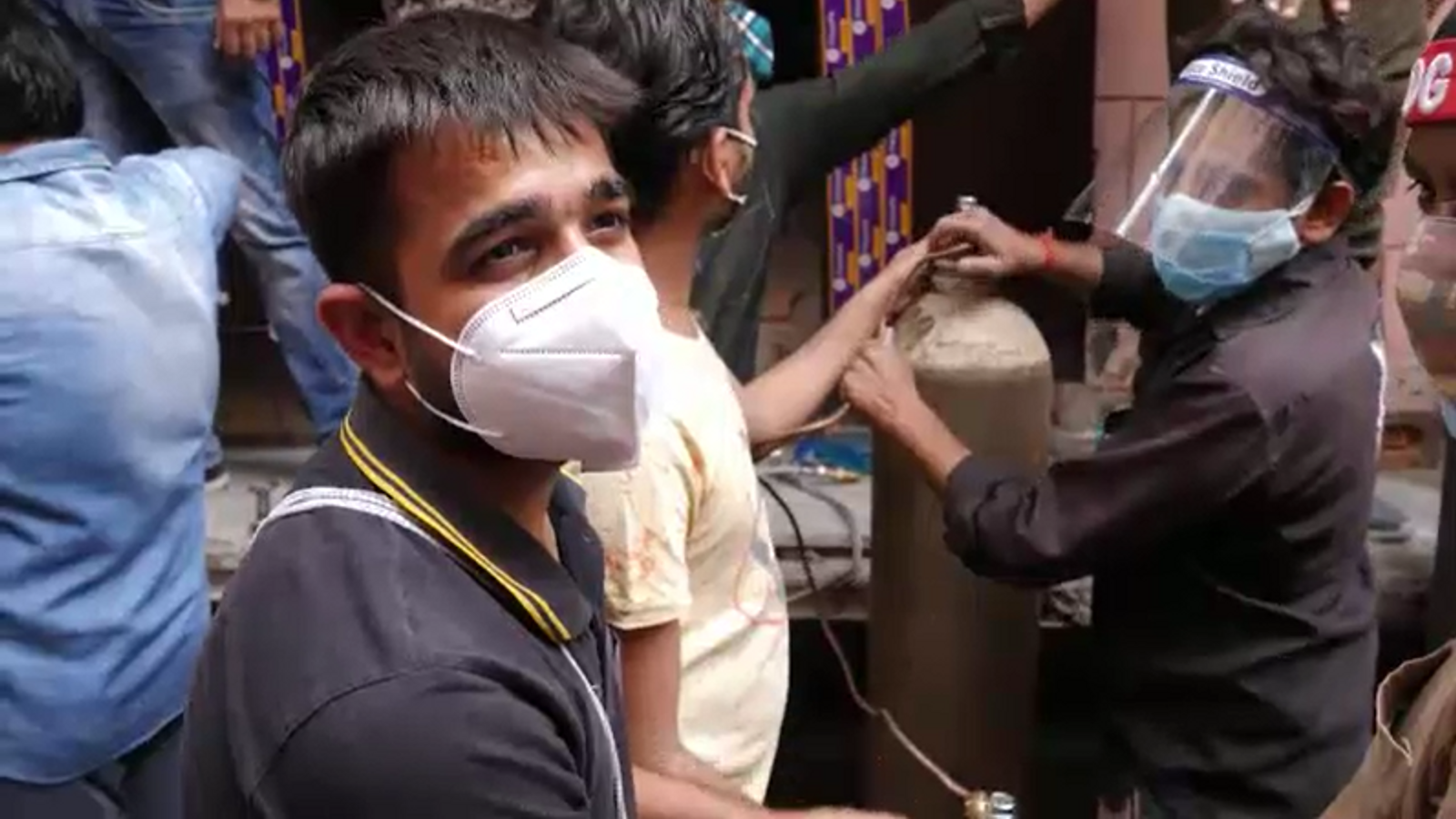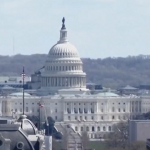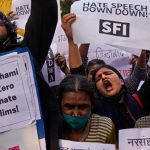Watching young and old Indians racing down alleyways across New Delhi trying to buy up oxygen to keep their relatives alive is a devastating sight.
We saw a young man push his way to the front of a very, very long queue – a queue to buy air – and then beg and plead for his cylinders to be filled.
“Brother please”, he said to the worker filling the bottles, “my grandmother is on her deathbed. I’ve been sent by the hospital. Please fill mine”.
His brow was furrowed. He had sweat dripping down his forehead. He had a look of sheer desperation.
The worker in charge of filling tanks recognised it straight away – that sense that this was a human who was very much on the edge and pushed to his limit.
He gave in to him – to the wails of protest from those who’d already spent hours in line waiting for their cylinders to be filled.
“I’ve been going non-stop for the last three days,” Harshit Khattar told us. “I haven’t eaten or anything. I’m just going from place to place trying to find oxygen for my grandmother.
“She’s on a ventilator in the hospital and the hospital doesn’t have any oxygen so they told me to go out and find some.”
He jumped into a taxi with his two cylinders and gave us a polite wave. It was going to take him an hour and 15 minutes to drive out of Delhi and into a neighbouring state to deliver his bottles of life to the hospital.
And then his search would start all over again.
How has it come to this for a country that used to be the fastest growing economy in the world and run TV adverts every few minutes proclaiming itself ‘Incredible India’?
How has the world’s greatest democracy found itself in a position where the government is appealing to Twitter chiefs to take down posts which criticise officials for their handling of the coronavirus crisis?
How has a country which announced so confidently that it had beaten the global pandemic in January, now become the world’s epicentre of the virus outbreak?
Many analysts and commentators are blaming it on political decisions – that allowing a selection of political rallies to go ahead which drew tens of thousands of people together encouraged the virus spread.
The decision to move the religious festival, the Kumbh Mela, to this year because of “auspicious dates” is not looking too wise in retrospect (an estimated ten million people have attended and it’s still going on until the end of May).
The very public and repeated political declarations that the country had conquered COVID may well have given people a false sense of security.
But there are also other significant factors which may have played a part.
Please use Chrome browser for a more accessible video player
India is one of the world’s leading manufacturers in vaccines – yet only around 2% of the population has had the full two inoculations.
The country delivered vaccines to multiple countries – including Bhutan which managed to vaccinate more than 90% of its population in 16 days whilst India itself ran out of vaccines for a week.
Indians are asking why the country didn’t make sure its own were safeguarded first.
The take-up has been small so far – possibly because of its huge population and reaching everybody but also because of fear about it and maybe the perception they didn’t need it if they’d beaten it.
Prime Minister Narendra Modi is now rolling it out to all adults over 18 from 1 May… and there’s likely to be a huge take-up this time.
The country’s also grappling with several variants and mutations.
The variants – one of which has been identified as the British variant discovered in Kent – seems to spread quicker, and those infected seem to need more oxygen and for a longer time.
This is all anecdotal evidence but this is what Indian doctors on the frontline are telling us – and their first-hand accounts of trying to save lives cannot be easily discounted.
There are also suggestions that even with the vaccine, which all health workers have received in India, the medics are getting reinfected, suggesting this may be a problem once the general population vaccinations are more widespread.
But the managing director of the Aakash Healthcare Super Speciality Hospital in Delhi, Dr Aashish Chaudhry told me his own personal experience.
He’d had COVID early on, then received the double vaccination but then caught coronavirus again.
However, this second time, he said, was a much more mild experience.
“We’ve found this with a lot of our doctors and nurses,” he said. “Last time, they were very seriously ill if they caught it. But this time, they are much more comfortable and able to isolate at home for a couple of weeks and then return. So, people should not be put off being vaccinated.”
There are other factors though which may have contributed to the near collapse of the health system and sharp spike in cases.
Successive governments have spent little on public health – less than 2% of Gross Domestic Product (GDP) – while the spending on defence and the military is nearly double that at $71.1bn in 2019.
This makes it the third highest spender on defence in the world after America and China.
There are around 500 oxygen manufacturing plants in India and none inside the capital.
The authorities have restricted oxygen manufacturing to small-scale industries inside Delhi – because of pollution worries, expense and space.
This means only one hospital in the capital has its own oxygen manufacturing plant, and it’s a government hospital.
The rest have to rely on the transportation of liquid oxygen from the plants scattered around the country and often many hundreds of kilometres away.
The huge numbers infected has meant a drain on oxygen and states have been accused of harbouring oxygen for their own residents rather than shipping it across state borders to places like Delhi.
The authorities have also dragged their feet in allowing the building of more than 160 PSA oxygen plants (Pressure Swing Absorption) which separates the gases from a mixture in the atmosphere to generate concentrated oxygen that can be supplied to hospital beds to a pipeline.
As far as we can make out, there’s only one possibly functional in Delhi (at the Burari Hospital in Kashik Enclave which was installed on 17 March) because tenders have taken so long. The prime minister has in the last few days instructed officials to speed this up.
But there appear to be challenges with the distribution system of liquid oxygen. It needs to be transported in specialised tankers but there aren’t enough to move the required amounts and there is a shortage of cylinders.
Follow the Daily podcast on Apple Podcasts, Google Podcasts, Spotify, Spreaker
Dr Chaudhry from Aakash hospital has decided to take matters into his own hands, searching the internet for manufacturers where he can purchase his own oxygen manufacturing plants.
He said: “Now since we’ve experienced it, that in times of crisis that we’d end up in such a situation when the life of the patient is put to risk, I think we need to take some steps so that we become more independent and not depend on the weak distribution supply chain that’s existing there currently.”
He hopes to have the plant up and running within a fortnight and is already expressing regret he didn’t do this before. “We never thought we’d need it. We relied on others.”
And I guess what Indians are fast realising is that it’s a very dangerous position to be in.






















